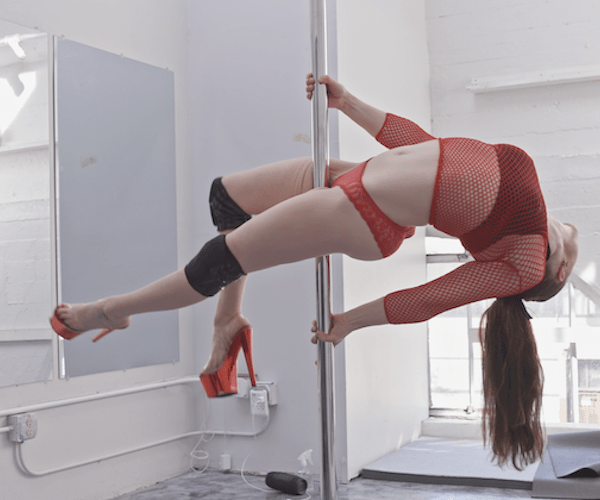Television Review: “Strip Down, Rise Up” — The Liberation of Pole Dancing
By Sarah Osman
An intriguing look at smashing the patriarchy through the art of pole dancing.

A scene from Strip Down, Rise Up. Photo: Netflix
For a brief period in my early 20s, I took up pole dancing. Having heard it was great for building upper body strength, I decided to try to use this exercise to pump up some of my muscles. I found pole dancing far more difficult than I suspected it would be — I could only do the simplest of tricks. Still, I was proud of what maneuvers I could manage and felt quite powerful accomplishing what I did.
The documentary Strip Down, Rise Up, premiering on Friday on Netflix, offers compelling testimony to the rejuvenating power of pole dancing. We have come far in terms of women’s rights, but society and culture continue to exert pernicious control over collective perceptions of the female body. Women are often told that their bodies are not desirable if they don’t fit a specific unrealistic standard (men face this hazard as well). Of course, males are able to take control of women’s bodies without their consent. Given traditional conceptions of beauty and power, women do not always feel comfortable with their own sexuality and femininity.
Shelia Kelley, the owner of S Factor, wants women to embrace their power. She is one of the focal points of the documentary, and arguably its most famous participant — she has appeared on Oprah and written multiple books. Kelley, who has studios all over America and is now branching out internationally, runs a series of pole and sensual dancing courses. Her signature seminar is a six-month journey of self-discovery with Kelley; the seminar incorporates dance classes and group therapy, with women supporting each other by sharing what brought them to the class. It’s empowering to see these ladies form a strong sisterhood. Watching members of the class cheer each other on as they master a new move is endearing, an inspiring homage to the force of female friendships.
The reasons why women go to the S Factor vary from playful to bleak. One woman’s girlfriend took the course and it unleashed her “sexual goddess.” Her partner wanted to feel that energy as well. One woman was intrigued by pole dancing. Another woman’s husband had died a year and a half before and she was beginning her search for happiness. Another woman had never felt sexy. One of the heaviest (yet moving) stories comes from Megan, a talented gymnast who was sexually abused by the monster doctor Larry Nassar. Megan bravely shares her story, as well as footage of her testifying against Nassar (and witnessing, with satisfaction, his sentencing). Watching Megan’s transformation — from being scared of sexuality to owning it — is a truly moving experience, a convincing demonstration of how dynamic pole and sensual dance can be.

A scene from Strip Down, Rise Up. Photo: Netflix
Kelley isn’t the only owner and teacher featured. Amy Bond, who owns San Francisco Pole and Dance, offers pole and aerial classes; she is also a professional pole dancer. That doesn’t mean she works in a gentleman’s club — Bond competes in pole dancing competitions, where pole artistry of various types is on display. Some of the tricks these women do are jaw-dropping: mastering pole dancing calls for overcoming formidable psychological and physical challenges. Unlike Shelley’s studio, Bond also allows men to take her classes; it’s interesting to see some of these men embrace their own sexuality. Bond’s story is also rather compelling, given that she grew up in the Mormon church before moving to L.A. to pursue acting. She ended up in pornography for a while before discovering pole dancing. To this day, men still leave comments on social media and elsewhere about her previous career (despite the fact she has not appeared in pornography for a good 20 years). Bond’s story dramatizes how men use sexuality to belittle or threaten women — if they start to claim their sexuality they are immediately ostracized.
Still, not all men featured in the film are misogynists. Shelley’s husband is quite supportive of her career and enjoys watching her dance. A few men come to S Factor to help women deal with the “male gaze” and comfort them as they face the trauma that comes with having an audience. Yet other men still remain far too bullying. The husband of one dancer is not supportive of her dancing; he forbids her from posting videos of it on social media (a primary way performers show off their skills and attract new students). She finally decides that it’s her body; it’s up to her to choose if she wants to put it on social media. When she begins to post her dancing on Instagram, her husband immediately asks for a divorce. It’s not just men who are uncomfortable with pole dancing: one woman who joins the S Factor drops out because she did not want her son to ever see her dance. And she has trouble dealing with her sexuality.
The film’s message is uplifting rather than titillating. Strip Down, Rise Up makes it clear that pole dancing doesn’t deserve the social stigma it is saddled with. Sexual dance allows women to heal from the trauma of blatant sexism as well as from the physical abuse that many have dealt with since childhood. By the end of their course with Kelley most of the women have begun to embrace their bodies and have formed valuable friendships along the way. These ladies are taking down the patriarchy — one pole dance at a time.
Sarah Mina Osman is a writer living in Los Angeles. She has written for Young Hollywood and High Voltage Magazine. She will be featured in the upcoming anthology Fury: Women’s Lived Experiences under the Trump Era.
